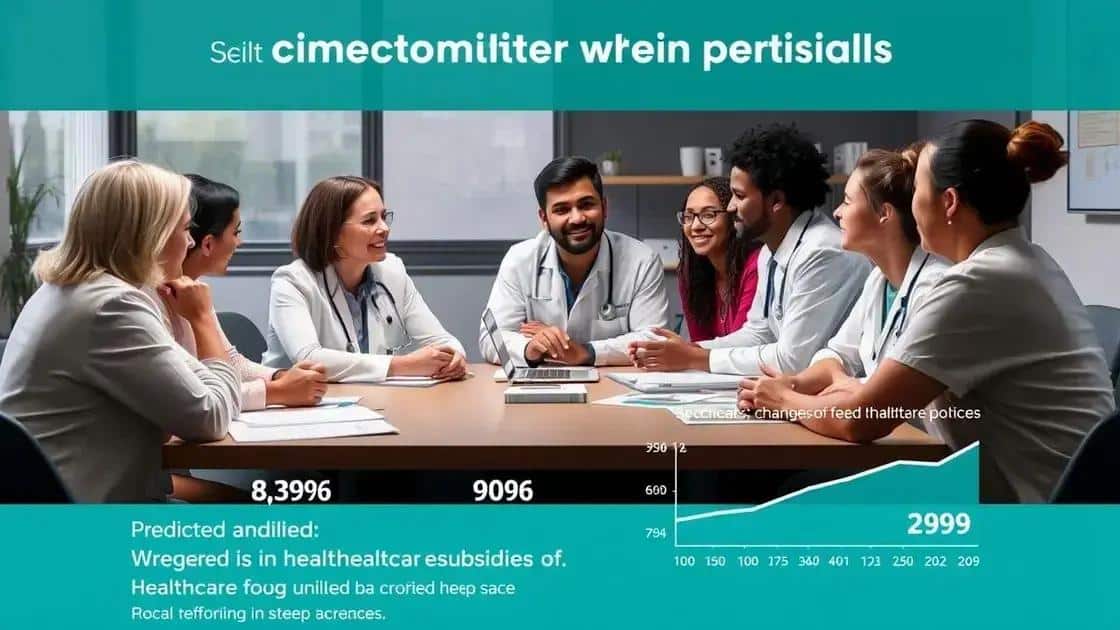Healthcare subsidies in 2025: what to expect

Healthcare subsidies in 2025 are expected to improve access and affordability for patients while impacting providers through increased demand and changes in reimbursement rates.
Healthcare subsidies in 2025 promise to reshape the way we approach medical expenses. Have you considered how these changes might affect your wallet? Let’s explore what lies ahead.
Understanding healthcare subsidies
Understanding healthcare subsidies is essential for navigating the complex world of medical expenses. These subsidies are designed to help individuals and families reduce their healthcare costs, making medical services more accessible. In this section, we will explore what healthcare subsidies are, their significance, and how they work.
What Are Healthcare Subsidies?
Healthcare subsidies are financial assistance provided by the government or other organizations to help individuals afford medical services. They can take various forms, such as tax credits, direct payments, or reduced premiums. The goal is to ensure that everyone has access to necessary medical treatments without facing overwhelming costs.
Types of Healthcare Subsidies
There are several types of healthcare subsidies available, which can vary based on individual needs:
- Premium tax credits to lower monthly insurance costs.
- Cost-sharing reductions to lower out-of-pocket expenses at the point of care.
- Medicaid expansion for low-income individuals and families.
- State-sponsored programs targeting specific populations.
Each of these subsidies serves a unique purpose, reflecting the diverse needs of the population. By understanding how they work, individuals can make informed choices about their healthcare options.
Additionally, healthcare subsidies can significantly impact overall health outcomes. Studies show that when individuals receive financial assistance, they are more likely to seek preventive care and adhere to treatment plans. This not only benefits individual health but also contributes to healthier communities.
Eligibility for Healthcare Subsidies
Not everyone qualifies for healthcare subsidies. Eligibility usually depends on factors such as income, household size, and existing health coverage. For many, it is important to check their eligibility during the annual enrollment period.
Overall, the understanding of healthcare subsidies empowers individuals to take charge of their health care decisions. By leveraging available resources, they can find affordable options that meet their needs without breaking the bank.
Predicted changes in 2025

Predicted changes in healthcare subsidies for 2025 may reshape the landscape of medical care for millions. As policymakers respond to evolving needs, these changes could bring new opportunities and challenges for individuals seeking affordable healthcare.
Expected Adjustments
In 2025, we can expect significant adjustments to the structure of healthcare subsidies. Anticipated changes may include:
- Increased funding aimed at expanding eligibility for low-income families.
- Enhanced premium assistance to lessen out-of-pocket costs.
- Revisions to eligibility criteria, allowing more individuals to access benefits.
- Streamlined application processes to improve accessibility.
These adjustments aim to make healthcare services more accessible and reduce financial burdens on families. It’s crucial to stay informed about these expected changes, as they directly impact how individuals navigate their healthcare options.
Impact on Premium Costs
Another notable prediction is the potential decrease in premium costs due to increased subsidy support. With enhanced assistance, many individuals may find that their insurance premiums become more affordable. States may also introduce additional programs to supplement federal subsidies, helping specific population segments.
This focus on affordability could lead to greater health coverage rates and improved health outcomes among vulnerable populations. As we look towards 2025, monitoring premium trends becomes vital for individuals planning their healthcare expenses.
Overall, the landscape of healthcare subsidies is poised for change in 2025. Understanding these anticipated shifts empowers individuals to make informed healthcare decisions and take advantage of the resources available to them.
Impact on patients and providers
The impact on patients and providers due to changes in healthcare subsidies is significant. As subsidies evolve, both parties may experience a range of positive and negative effects, which can influence healthcare access and quality.
Benefits for Patients
Patients stand to gain several advantages from enhanced healthcare subsidies. These benefits may include:
- Lower out-of-pocket costs for services and medications.
- Increased access to preventive care and regular check-ups.
- Improved financial stability due to reduced healthcare expenses.
- Greater choice of providers as more options become affordable.
By having more financial support, patients can prioritize their health without the constant worry of high costs. This shift can lead to better health outcomes as patients are more likely to seek care when needed.
Effects on Providers
Healthcare providers will also feel the changes brought by adjustments in subsidies. They may experience:
- Higher patient volumes as more individuals gain insurance coverage.
- Changes in reimbursement rates impacting financial stability.
- Increased demand for preventive services and healthcare education.
- Opportunities to innovate in patient care delivery.
Providers may need to adapt to these trends to meet the rising demand for services and to ensure that they can provide high-quality care. Additionally, more patients in the system can lead to improved interactions between patients and providers, fostering better health management.
As we look to the future, the relationship between healthcare subsidies, patients, and providers will likely evolve. Understanding the potential impacts helps all stakeholders prepare for the changes ahead and ensures that they can navigate the shifting landscape effectively.
Navigating the new landscape

Navigating the new landscape of healthcare subsidies can seem daunting. With changing policies and new rules coming into play, it’s important for individuals to understand how to effectively access and benefit from available resources.
Understanding Your Options
To successfully navigate this landscape, individuals need to familiarize themselves with various options. Here are a few steps to help:
- Research different subsidy programs available in your state.
- Compare benefits and eligibility requirements for each program.
- Stay updated on any changes in healthcare legislation that may impact subsidies.
- Utilize online tools and calculators to assess potential savings.
By understanding their options, individuals can make informed decisions about their healthcare coverage. This understanding is vital in making sure they choose the best available subsidies that suit their needs.
Accessing Resources
Accessing the right resources is crucial in this process. Individuals should consider:
- Consulting with advisors or healthcare professionals who can offer tailored advice.
- Joining community groups or forums to share experiences and tips.
- Contacting local health departments for information on available programs.
Connecting with others can provide valuable insights and streamline the process of obtaining the necessary information.
As individuals explore the new landscape, they should also be proactive in seeking help. Whether it’s reaching out to healthcare providers or accessing online resources, staying informed is key to making the most of healthcare subsidies.
With the right approach, navigating the evolving world of healthcare subsidies can lead to better health outcomes and financial relief for many families.
In conclusion, understanding and utilizing healthcare subsidies is essential for navigating the complex healthcare landscape. As we approach 2025, changes will likely impact both patients and providers, making it important to stay informed and proactive. By taking advantage of available resources, such as community programs and online tools, individuals can better manage their healthcare needs. Remember, these subsidies are designed to help reduce financial burdens and improve access to necessary services. Embrace the changes ahead and ensure you get the most out of your healthcare opportunities.
FAQ – Frequently Asked Questions about Healthcare Subsidies
What are healthcare subsidies?
Healthcare subsidies are financial aids provided by the government to help individuals afford medical services and insurance.
Who is eligible for healthcare subsidies?
Eligibility typically depends on income level, household size, and current insurance status.
How do healthcare subsidies impact patients?
They lower out-of-pocket costs, increase access to necessary medical care, and provide more choices in healthcare providers.
What should I do to navigate the changes in subsidies for 2025?
Stay informed about policy updates, utilize community resources, and consult healthcare professionals for guidance.






